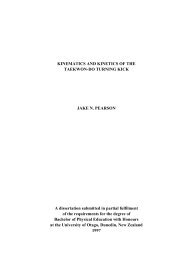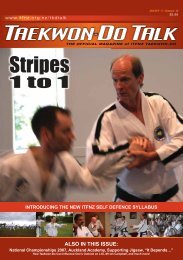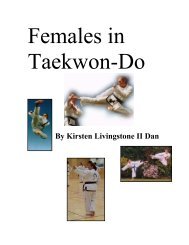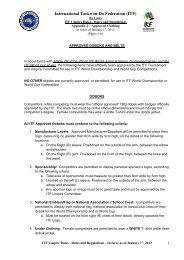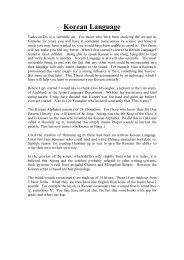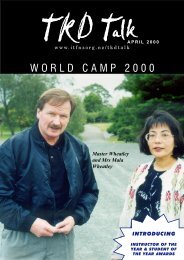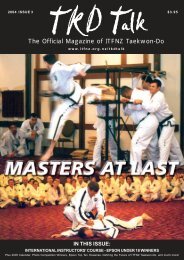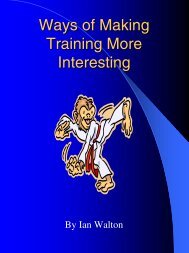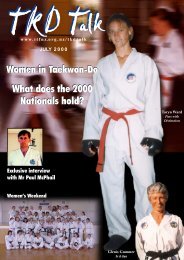Niketa Wells - International Taekwon-do Federation of New Zealand
Niketa Wells - International Taekwon-do Federation of New Zealand
Niketa Wells - International Taekwon-do Federation of New Zealand
You also want an ePaper? Increase the reach of your titles
YUMPU automatically turns print PDFs into web optimized ePapers that Google loves.
REGULAROPTIMAL EARLY TREATMENT OF COMMON SOFT TISSUE INJURIESBy Dr Jake Pearson IV dan, KhandallahSPORTS MEDICINELike it or not, injuries are an unavoidableconsequence <strong>of</strong> participation in anyphysically demanding activity. Hopefullythese are mild, however, and with goodtreatment the interruption to trainingrelatively brief. For our elite athletes, thedifference <strong>of</strong> a few days’ recovery canbe crucial, particularly around the time<strong>of</strong> major competition, but even for those<strong>of</strong> us at the more recreational end <strong>of</strong>the spectrum it is useful to know how tomaximise speed and quality <strong>of</strong> recovery.I am talking here about joint sprains, musclestrains or significant contusion/bruising. Afew specific joint injuries have been coveredin previous articles, and some, for exampleACL injuries in the knee, require morespecialised treatment. However, for mostmild to moderate injuries the followingprinciples will apply. I see patients in myclinic every day who are suffering mediumorlong-term consequences at least in partdue to inappropriate initial treatment. It ispossible to be overprotective <strong>of</strong> an injuryand cause other problems or delayedrecovery; however, it is my hunch thatthe majority <strong>of</strong> TKDers may rather havea tendency to “tough it out” or brush <strong>of</strong>fthese sorts <strong>of</strong> injuries, and their bodies maysuffer as a result.The treatment during the first 24 hoursfollowing an injury is the most important,and the age-old acronym <strong>of</strong> RICE (rest,ice, compression, elevation) remainsthe cornerstone <strong>of</strong> early management.It has been suggested that this shouldbe expanded to PRICE (addition <strong>of</strong>‘protection’ i.e. from further injury with abrace/splint for a period for some injuries)or even to PRICED (addition <strong>of</strong> ‘diagnosis’at the end, particularly if things <strong>do</strong> notsettle reasonably quickly, obviously fromsomeone suitably qualified rather thanDr Google). The primary aim <strong>of</strong> thesemeasures is to minimise the degree <strong>of</strong>bleeding, which can cause further tissuedamage and inhibit healing.Rest is hopefully self-explanatory.Remember this applies to the injured bodypart only, and it is usually possible to stayactive in some way without stressing thedamaged area. Ice is best applied for 10-15 min. intervals every30-60 mins. Beware <strong>of</strong>“ice burns” from verycold substances helddirectly on the skin.Compression is usuallybest achieved with abandage, ideally withice treatment appliedsimultaneously. Firmpressure should beapplied but not sotight as to cause pain.Elevation: the injuredpart should ideallybe above the level <strong>of</strong>the shoulder (arm/hand injury) or pelvis(leg/foot injury) toencourage drainage <strong>of</strong>extra fluid. In additionto P/RICE/D, youshould avoid HARM inthe early stages – Heat,Alcohol, Running/exercise, and Massage.Most <strong>of</strong> these are selfexplanatory,althoughavoiding massagemay surprise some;remember this applies to the first 24-48hours after injury and also to firm massagedirectly on the injured area as opposed tosurrounding areas.Whether or not to immobilise with a cast,splint or strapping depends a lot on thenature and severity <strong>of</strong> the specific injury;however, there <strong>of</strong>ten is a role for a fairlyhigh degree <strong>of</strong> protection in the first 24-48 hours for moderately severe injuries.The art then is to know how much toget moving and in what way, and the term‘protected mobilisation’ describes this. Theinput <strong>of</strong> an appropriately trained healthpr<strong>of</strong>essional at this point is desirable.The role <strong>of</strong> anti-inflammatory medication(e.g. “Voltaren” or “Neur<strong>of</strong>en”) in theearly stages <strong>of</strong> s<strong>of</strong>t tissue injury remainsa contentious topic. My advice is toavoid these if possible for the first 48hours (there is the possibility they couldincrease bleeding early on), and ratherto use regular Paracetamol (“Pana<strong>do</strong>l”)for pain relief. There is evidence thattaking anti-inflammatories between days2-10 following an ankle sprain speeds uprecovery; however, whether there is anylonger-term effect on healing is uncertain.Completing an appropriate rehabilitationprogram under guidance <strong>of</strong> your healthpr<strong>of</strong>essional is then the key to recoveringas quickly and completely as possible.In generally this will involve regainingmovement, then strength and finallyfunction in approximately that order,with some overlap. Rehabilitation usuallycontinues well after an athlete has returnedto their sport. Many people underestimatethe time and effort required for this, andthe quality <strong>of</strong> their recovery may reflectthis.Remember though that avoiding injury ispreferable to even the best treatment. Sogo hard but also “take care out there”.ISSUE TWO, 201243



